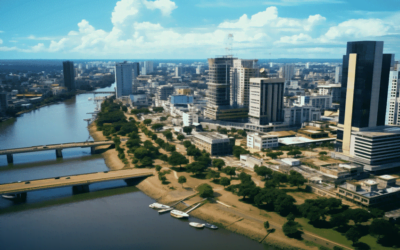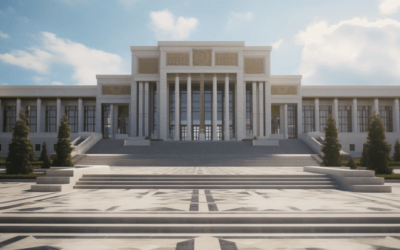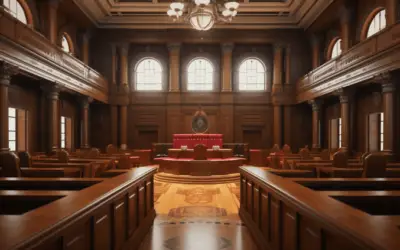Hey there, fellow drone enthusiasts and curious minds seeking insight into Nepal’s drone laws! I understand the thrill of flying drones and the excitement of capturing breathtaking aerial views.
If you’re here, you’re probably as eager as I was to explore the fascinating world of drone regulations in Nepal. It’s a topic that often raises a lot of questions, and I’m here to help you navigate through the complexities.
During my journey to uncover the ins and outs of Nepal’s drone laws, I delved into extensive research.
I wanted to provide you with accurate, reliable, and up-to-date information that comes from a place of expertise. I’ve combed through official resources, dug deep into the Civil Aviation Authority of Nepal’s guidelines, and scoured the internet for insights from experienced drone operators.
The result? Well, it’s all right here in this article, so you can confidently understand the drone laws in Nepal.
If you’re seeking clarity on Nepal’s drone regulations, you’re in the right place. I’ve got the answers you need to navigate the sky-high world of drone flying in Nepal.
From the rules that apply to residents and tourists to the specific guidelines for hobbyists, commercial operators, and government entities, this article will provide you with a comprehensive understanding of Nepal’s drone laws.
So, read on, and let’s explore the drone laws of this beautiful country together. Whether you’re a seasoned drone pilot or a beginner, this article will ensure that you’re well-prepared to soar through Nepal’s skies legally and responsibly.
- General Rules for Flying a Drone in Nepal
- Categories of Drone Operators in Nepal
- Nepal Registration and Permit Requirements
- Restricted Areas for Drone Operations in Nepal
- Nepal Additional Guidelines for Drone Operators
- Drones for Tourists and Foreign Operators in Nepal
- Traveling with Drones in Nepal
- Final Thoughts on Nepal Drone Laws
- Frequently Asked Questions About Nepal Drone Laws
General Rules for Flying a Drone in Nepal

Alright, let’s dive into the nitty-gritty of drone rules in Nepal. If you’re planning to fly a drone in this beautiful country, it’s vital to understand the general rules that keep the skies safe for everyone.
I’ve done some in-depth research to bring you the lowdown on Nepal’s drone laws. So, let’s get started.
The Weighty Matter of Drones and Authorization
Now, first things first. Nepal’s drone laws take into account the weight of your flying companion. If your drone weighs more than 2 kilograms (about 4.5 pounds) and you intend to send it soaring 400 feet or more above the ground, you’ll need to secure authorization.
This involves reaching out to the Department of Tourism, the Ministry of Home Affairs, and, of course, the Civil Aviation Authority of Nepal (CAAN).
It’s like having the green light to embark on an aerial adventure. But if your drone weighs less than 2 kilograms, you have a bit more freedom—just stick to private property and keep it under 200 feet, and you’re good to go.
The Recklessness Factor
You know, when you’re up there in the sky, it’s easy to get carried away with the thrill. However, remember, safety always comes first.
Nepal’s drone laws explicitly state that flying recklessly is a no-go. That means no daredevil stunts, no dodging obstacles, and certainly no disrupting the peace below. Be a responsible drone pilot, and you’ll be helping to maintain the harmony of Nepal’s skies.
Altitude and Distance – Stay Within Limits
Flying high can be exhilarating, but it’s essential to keep things within bounds. Nepal’s laws limit the altitude of your drone to 120 meters, which is roughly 394 feet above ground level.
So, while you won’t be hitting the stratosphere, there’s still plenty of room for spectacular views. As for distance, don’t let your drone roam too far; the maximum range is 500 meters or approximately 1,640 feet.
Dropping Objects and Crowded Spaces
You might be tempted to get creative with your drone’s cargo, but it’s a big no-no. Nepal’s drone laws prohibit the use of drones for dropping objects or, heaven forbid, animals. We don’t want any surprise deliveries from the sky.
Also, steer clear of congested areas and maintain a distance of 150 meters from any crowded place. It’s all about keeping everyone on the ground safe and ensuring that drones don’t become a distraction.
Keeping an Eye on Your Drone
Do you know the feeling of keeping an eye on your beloved drone as it explores the sky? Well, Nepal’s got your back on that one.
The regulations require drone operators to maintain unaided visual sight with their drones. It’s like having a watchful guardian in the sky, making sure your drone stays on the right path and doesn’t go astray.
So, there you have it, the general rules for flying a drone in Nepal. These guidelines are all about ensuring that you and your drone can take to the skies while respecting the safety and privacy of those on the ground.
But there’s more to discover in this article, so keep reading to become a Nepal drone law expert.
Also Read: Drone Laws in Nauru 2024
Categories of Drone Operators in Nepal

Alright, let’s take a closer look at the different categories of drone operators in Nepal. Whether you’re a hobbyist who enjoys flying for fun or a commercial operator looking to turn your passion into a profession, Nepal’s drone laws have specific regulations tailored to your needs.
And if you’re a visitor or part of a government entity, some rules apply to you as well. I’m here to break it all down for you.
From Hobbyists to Government Entities
Nepal’s drone laws acknowledge the diverse world of drone enthusiasts. First up, we’ve got the hobbyists. These are the folks who simply love taking their drones for a spin for personal enjoyment.
The great news for hobbyists is that you don’t need a specific drone pilot license to fly in Nepal. However, you should still get your drone registered and authorized for that added layer of compliance.
Commercial operators, on the other hand, might be flying drones for professional purposes like photography, videography, or surveying.
Here, you don’t require a drone pilot license either, but you must ensure your drone is registered and authorized for commercial use. It’s all about keeping things in order when you’re turning your passion into a profession.
If you’re visiting Nepal and itching to capture its beauty from the sky, you’re in luck. Foreign visitors are allowed to fly drones in Nepal, but there’s a catch. You’ll need to register your drone and get the necessary authorization for your flights.
It’s all about ensuring that even tourists follow the rules while enjoying Nepal’s stunning landscapes.
Lastly, we have government drone operators. Now, these guys do need a drone pilot license to operate drones in Nepal.
Government entities must also register their drones and get the required authorization, just like everyone else. It’s all about keeping the skies safe and organized for all operators, whether for leisure or official purposes.
Regulations and Licensing Requirements
When it comes to the nitty-gritty, Nepal’s drone laws are clear and concise. They ensure that everyone knows their role and responsibility in the drone ecosystem.
For hobbyists and commercial operators, remember to get your drones registered with the Civil Aviation Authority of Nepal (CAAN). The authorization process might seem like a hurdle, but it’s all about ensuring safety and compliance.
Foreign visitors looking to explore Nepal from the air should take note of the need for registration and authorization, just like any other drone operator in the country. It’s all part of Nepal’s commitment to safe and responsible drone flying.
As for government entities, the drone pilot license requirement ensures that those operating drones for official purposes have the necessary training and expertise. This commitment to professionalism is in line with international standards and keeps the skies secure for all.
So, no matter which category you fall into, Nepal’s drone laws have a set of rules designed to cater to your specific needs. It’s all about making the skies safe and accessible for every drone enthusiast out there.
Also Read: Drone Laws in Namibia 2024
Nepal Registration and Permit Requirements

Now, let’s talk about the essential steps for drone operators in Nepal – registration and permits. To ensure that your drone activities comply with the law, it’s vital to understand how to register your drone with the Civil Aviation Authority of Nepal (CAAN) and acquire the necessary permits. Let’s unravel this process together.
The Registration Process
Registering your drone with CAAN is a straightforward yet crucial step. It’s like giving your drone an official identity card in Nepal.
You’ll need to provide all the necessary details about your drone, including its make, model, and serial number. The purpose of registration is to ensure accountability and traceability. It’s also your way of saying, “I respect the rules, and I’m ready to fly responsibly.”
The Unique Identification Number
Once your registration is successful, you’ll receive a unique identification number for your drone. It’s like your drone’s very own passport in the sky.
This number helps authorities keep track of your drone, ensuring that it’s a part of the legal fleet. Remember to keep this number handy whenever you fly your drone in Nepal.
Navigating Public Spaces and National Parks
Flying your drone in public spaces, especially national parks, requires a little extra effort. You’ll need to obtain approval from the local administration office for flights up to 200 feet.
National parks, being unique and delicate environments, require additional authorization from the National Park Administration. This might seem like a lot of paperwork, but it’s all about preserving these incredible natural treasures while still enjoying your drone flights.
So, there you have it – the necessary steps for registering your drone with CAAN in Nepal and the added considerations when flying in public spaces, particularly in national parks. It’s all about ensuring your drone operations align with Nepal’s beautiful landscapes and the safety and privacy of its people.
Also Read: Drone Laws in Myanmar (Burma) 2024
Restricted Areas for Drone Operations in Nepal

As drone enthusiasts, we’re all about exploring the skies, but there are some places where our drones should never roam. Let’s talk about the restricted areas for drone operations in Nepal. It’s essential to know where we can’t fly to keep our skies safe and respect Nepal’s cultural, heritage, and security zones.
Designated Restricted Areas
Nepal’s drone laws specify a few key areas where drone operations are off-limits. First and foremost, we must keep a respectful distance from airports.
Within a 5-kilometer radius of these areas, drones shouldn’t take flight. It’s all about ensuring the safety of manned aircraft and preventing any potential disruptions.
Sensitive Zones and Government Offices
The restrictions don’t stop there. Drones are also prohibited within a 5-kilometer horizontal distance of international boundaries. This helps maintain security and respect for neighboring countries.
Moreover, certain cultural and heritage sites, religious places, government offices, military installations, and even the offices of prominent figures are off-limits up to a 1-kilometer aerial radius. These are the areas that demand our utmost respect and sensitivity.
Provincial and Local Governance
In addition to these nationally designated restricted areas, keep in mind that provincial and local governments in Nepal may establish their own no-fly zones.
These zones might vary from place to place, so it’s crucial to stay updated with local regulations when planning your drone flights. Remember, respecting these boundaries is not only about compliance but also about preserving the beauty and sanctity of these locations.
So, while the sky’s the limit in many areas, there are certain places where our drones should remain grounded. These restrictions are in place to ensure safety, security, and the preservation of Nepal’s rich culture and heritage.
It’s all part of being responsible drone operators and contributing to the harmonious coexistence of drones and the stunning landscapes of Nepal.
Also Read: Drone Laws in Mozambique 2024
Nepal Additional Guidelines for Drone Operators

Operating a drone is not just about following laws and regulations; it’s also about practicing responsible and safe drone flying. Let’s dive into some additional guidelines that are crucial for all drone operators in Nepal, whether you’re a hobbyist, a commercial flyer, a tourist, or a government entity.
General Guidelines for Responsible Flying
Safety first, right? Always ensure that your drone is in optimal working condition before takeoff. Regular maintenance and checks will prevent any unexpected mishaps during the flight.
When you’re out flying, it’s a good idea to carry a first aid kit and fire extinguisher, especially if you’re in remote areas. It’s all about being prepared for any unforeseen events.
Respecting Privacy and Sensitive Areas
One of the cardinal rules of responsible drone flying is respecting the privacy of individuals. Avoid capturing images or videos of people without their consent, and don’t invade their personal space with your drone.
Additionally, steer clear of sensitive areas, such as government or military facilities. Flying over these locations can lead to unwanted attention and potential legal issues. Always err on the side of caution to ensure a harmonious drone operation experience for all.
So, in addition to adhering to Nepal’s drone laws, these extra guidelines are all about fostering a culture of responsible drone flying.
By maintaining safety measures, respecting privacy, and avoiding sensitive areas, we can collectively ensure that the skies remain a place of adventure and enjoyment for everyone.
Also Read: Drone Laws in Morocco 2024
Drones for Tourists and Foreign Operators in Nepal

Nepal is a destination that’s bound to ignite your wanderlust, and what better way to capture its stunning landscapes than with a drone? But before you launch your bird into the Nepalese skies, there are a few things you should know about the regulations and permissions for foreign visitors and tourists.
Regulations and Permission Requirements
Nepal is welcoming to tourists and foreign operators who want to experience the thrill of flying drones in its picturesque landscapes. However, there’s a process to follow.
The first step is to ensure that you register your drone and acquire the necessary authorization for your flights. It might seem like paperwork, but it’s all about ensuring that your drone flights are in line with Nepal’s rules and regulations.
Obtaining Valid Permission
The key to a smooth drone-flying experience in Nepal as a foreign visitor or tourist is to obtain valid permission from relevant authorities. This means reaching out to the Ministry of Home Affairs, the Department of Tourism, and the Civil Aviation Authority of Nepal.
By acquiring these permissions, you’re not only following the law but also showing respect for the country’s rules and culture. It’s all part of ensuring a memorable and hassle-free experience during your drone adventures in Nepal.
So, if you’re planning to capture Nepal’s breathtaking beauty from the sky, remember that you can do it as a foreign visitor or tourist.
Just be sure to navigate the registration and permission process to ensure that your drone flights are not only legal but also respectful of Nepal’s regulations and traditions.
Also Read: Drone Laws in Montenegro 2024
Traveling with Drones in Nepal

As drone enthusiasts, we’re always on the lookout for the perfect shot, and sometimes that means taking our drones on our travels.
Let’s delve into some essential guidelines for travelers who are thinking about bringing their drones on airplanes. It’s all about ensuring that your trusty flying companion arrives at your destination safe and sound.
Guidelines for Travelers
When it comes to traveling with your drone, there are a few guidelines that can make the process smoother. First and foremost, ensure that your drone is packed securely in your luggage.
Use a sturdy, well-padded case to protect it from any bumps and jostles during your journey. Remember to disassemble your drone as per manufacturer instructions to minimize any potential damage.
Carry-on Luggage for Safety
Here’s a tip that can save you from a major headache: always carry your drone in your carry-on luggage if possible. According to the Montreal Convention, airlines are only liable for losses up to a specific amount.
In international travel, the risk of lost luggage or theft can increase, particularly if you have multiple connecting flights. Carrying your drone with you ensures that it’s in your control throughout the journey.
Drone Batteries and Checked Baggage
While packing your drone, it’s crucial to remember that drone batteries are considered “dangerous goods” by airlines.
Due to previous incidents of these batteries catching fire, airline rules surrounding them are incredibly strict. Therefore, never place your drone batteries in your checked baggage. Instead, carry them in your carry-on bag.
This simple step can save you from potential issues like the airline seizing your batteries, hefty fines, or even being denied boarding.
So, when you’re traveling with your drone, a bit of extra care goes a long way. Pack it securely, opt for carry-on luggage to reduce the risk of loss or theft, and always remember to keep your drone batteries in your carry-on bag.
It’s all about ensuring that your travel with your drone is as hassle-free as your flights are enjoyable.
Also Read: Drone Laws in Mongolia 2024
Final Thoughts on Nepal Drone Laws

Now that we’ve journeyed through the fascinating landscape of Nepal’s drone laws, it’s time to wrap things up. As drone enthusiasts, understanding these regulations is not just about following the rules; it’s about ensuring safety and respect for this beautiful nation.
In summary, Nepal’s drone laws are in place to balance our passion for flying with the need for security, privacy, and cultural preservation.
We’ve learned that these laws classify drones based on weight, require registration for many, and mandate respectful flying practices. Altitude and distance limitations are set, and some areas are designated as no-fly zones.
Every drone operator needs to comply with these laws to ensure both personal and public safety. By respecting the regulations, we not only have memorable drone adventures but also contribute to a positive image of drone enthusiasts in Nepal.
As we all know, regulations can change over time. That’s why it’s crucial to stay informed about the latest drone laws in Nepal. The Civil Aviation Authority of Nepal (CAAN) is your go-to source for accurate and up-to-date information.
If you have specific questions or concerns, don’t hesitate to reach out to them directly. Keeping yourself informed and well-versed in the laws ensures that your drone flights are not only legal but also respectful and enjoyable.
So, fellow drone adventurers, as we navigate the skies of Nepal, let’s do it with respect, responsibility, and an eagerness to explore the breathtaking landscapes while maintaining the highest standards of safety and compliance.
Frequently Asked Questions About Nepal Drone Laws
1. Can tourists fly drones in Nepal, and what are the requirements?
Tourists are allowed to fly drones in Nepal, but they must follow certain regulations and obtain proper permissions. To fly a drone in Nepal as a tourist, you need to register your drone with the Civil Aviation Authority of Nepal (CAAN).
You should also obtain permission from relevant authorities, including the Ministry of Home Affairs, the Department of Tourism, and CAAN. These steps ensure compliance with Nepal’s drone laws and respect for its cultural and security considerations.
2. What are the weight-based regulations for drones in Nepal?
In Nepal, drone regulations are categorized based on the weight of the drone. Drones weighing more than 2 kilograms (4.5 pounds) that fly 400 feet or more above ground level require prior authorization from the Department of Tourism, Ministry of Home Affairs, and the CAAN.
Drones weighing less than 2 kilograms do not need authorization from the CAAN if they are flown on private property and stay below 200 feet. These distinctions are crucial for drone operators to ensure they are following the appropriate rules.
3. What are the altitude and distance limitations for drone flights in Nepal?
Nepal’s drone laws specify certain altitude and distance limitations to ensure safety and respect for privacy.
Drones should not be flown higher than 120 meters (394 feet) and should not fly further than 500 meters (1,640 feet). These restrictions help prevent interference with other aircraft and maintain a safe operating environment for drones.
4. Are there any restricted areas for drone operations in Nepal?
Yes, there are designated restricted areas in Nepal where drone operations are prohibited.
These include airport areas (within 5 km), international boundaries (within 5 km horizontal distance), religious, heritage, and sacred sites (up to a radius of 1 km), government offices (up to 1 km aerial radius distance), military installations (up to 1 km), and other safety departments (up to 500m).
In addition to these national restrictions, provincial and local governments may establish their no-fly zones.
5. What safety measures should drone operators take when traveling with drones on airplanes?
When traveling with drones on airplanes, it’s crucial to follow safety guidelines. Drones should be securely packed in a well-padded case to protect them during the journey. It’s recommended to disassemble drones as per manufacturer instructions to minimize damage.
Drones should be carried in carry-on luggage to reduce the risk of loss or theft.
Importantly, drone batteries should never be placed in checked baggage due to strict airline regulations, as they are considered “dangerous goods.” Following these safety measures ensures a smooth and hassle-free travel experience with your drone.













